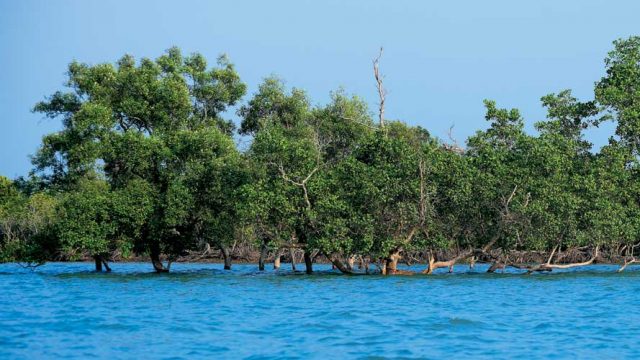The Sunderbans are amongst the largest mangrove forests in the world. These mangroves – a mixture of trees and shrubs growing in saline coastal habitats – encompass an enormous 4,000sq km in India and another 6,000sq km in Bangladesh. Egrets, kingfishers, herons, fiddler crabs, water monitor or tarkel, alligators, deer, Irrawady dolphins among other beautiful animals call Sunderbans their home. Every year, thousands of tourists throng to Sunderbans for a glimpse of the Royal Bengal Tiger. More often than not, they are disappointed. At last count, there were more than 250 tigers in the Sunderbans Reserve Area, but distributed over an expanse of 1,500sq km. The tigers have learnt to survive in this hostile territory; they are expert swimmers, drink salty water and (like good Bengalis) eat fish and crabs.

But the Sunderbans is not just about exotic flora and fauna. It is also home to one of the most resilient, yet desperately underprivileged, people. An intricate network of rivers and their tributaries enmesh the Sunderbans. Of the 102 islands, only 52 are inhabited. Till the Sunderbans was declared a UNESCO World Heritage Site in 1987 and a Biosphere Reserve in 1989, most of its human inhabitants made their living off the forest, either by collecting wax or honey, or trapping, felling and hunting.
Tip Most tourists will be under the supervision of their tour operators. There are strict rules concerning where you can go. There is an entry fee for going into the sanctuaries; these are paid for by the operator. Most reserves close at 5.30pm
THINGS TO SEE AND DO
Sajnekhali Tiger Reserve
The Sajnekhali Tiger Reserve is the centrepiece of your Sunderbans experience. This is the only place where one might safely step on the reserve proper. The complex also houses a Mangrove Interpretation Centre, a museum, a watchtower, a crocodile pond, an Olive Ridley turtles enclosure and the Herbivore Acclimatisation Centre for rehabilitating lost deer.
Sajnekhali Bird Sanctuary
Situated at the confluence of the Matla and Gumdi rivers, the sanctuary extends over an area of 885sq km. Here you can see a wide variety of birds, the most common include the spotted billed pelican, herring gull, Caspian tern, open-billed stork and paradise flycatcher. A rare winter migrant, the Asian dowitcher, can also be found here.

On a boat
Spending a day on the water is highly recommended. This may not be possible for large groups but if you are travelling with a tour operator who hosts small groups, try asking if you could be taken out on the water.
Visit the endless expanse of the mohona, the area where the waters of five rivers mingle. Or you might choose to spend an afternoon navigating the network of creeks and backwaters.
Tip Carry a good pair of binoculars
Village visits
Depending on who your tour operator is, you may be taken on a visit to one of the Sunderbans villages. NGOs here promote environment friendly local practices.
WHERE TO STAY AND EAT
Sunderbans Jungle Camp (Kolkata Tel: 033-24550917, 24549719, Cell: 09733- 000442), run by Help Tourism on Bali Island, is your best bet. They practise low-impact eco-tourism, and run the camp with the help of poachers-turned-conservators. Their all-inclusive 2D/ 1N package costs ₹17,515 per person (transfers from Kolkata, stay, meals, forest guides, etc). Sunderban Tiger Camp (Kolkata Tel: 32935749; Tariff: ₹4,800–6,470 per person) offers an all-inclusive 1N/ 2D package (Kolkata–Kolkata) for ₹4,800/ ₹4,930/ ₹6,150/ ₹6,470 (tent/ hut/ deluxe cottage/ executive cottage) per person. Cruise launches MV Chitralekha and MV Sarbajaya (Tel: 22436440, 22488271) run by WBTDC have 1N/ 2D package that costs ₹10,800 for two for a double-bedded cabin.
FAST FACTS
When to go The park is open all year round, but September–March is the best time to visit
Permits One doesn’t need a permit to make a boat trip through the Sunderbans outside the sanctuary area. Permits are, however, necessary to visit the estuarine delta area, Sajnekhali Sanctuary and the Project Tiger Reserve areas.
Indians can obtain the permits from the office of the Field Director, Sunderbans Tiger Reserve, Port Canning, 24 Parganas or the Forest Office at Sajnekhali
Foreigners should contact the Forest Department in Kolkata (below).
Those with passport and visa can get their permits from Sajnekhali
Tourist/ Wildlife offices
Field Director, Sunderbans Tiger Reserve, Canning PO, District 24 Parganas (South), Telefax: 03218-256159
Forest Department, Director, Sunderbans Biosphere Reserve Forest, Bikas Bhavan, 3rd Floor, North Block, Salt Lake, Kolkata, Tel: 033-23211750
STD code 03218
GETTING THERE
Air Nearest airport: Kolkata (112km/
3hrs). Taxi ₹8–12/km
Rail Nearest railhead: Port Canning (54km/ 1.5hrs). You then cross the river by boat. Then take a bus or shared auto to Sonakhali from where you can take a launch to Gosaba or Sajnekhali
Road From Kolkata, drive to Sonakhali via the Basanti Main Road; the road branches off from the EM Bypass (2hrs). Then travel to Sajnekhali by motorboat Bus daily services from the Kolkata Bus Stand at Dharamtala and Babughat to Namkhana (106km), Raidighi (76km), Sonakhali (88km) and Najatare (92km), from where private and as West Bengal Tourism’s motor launch services are available




